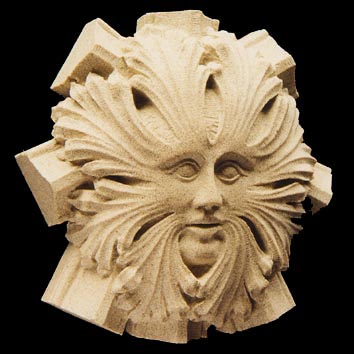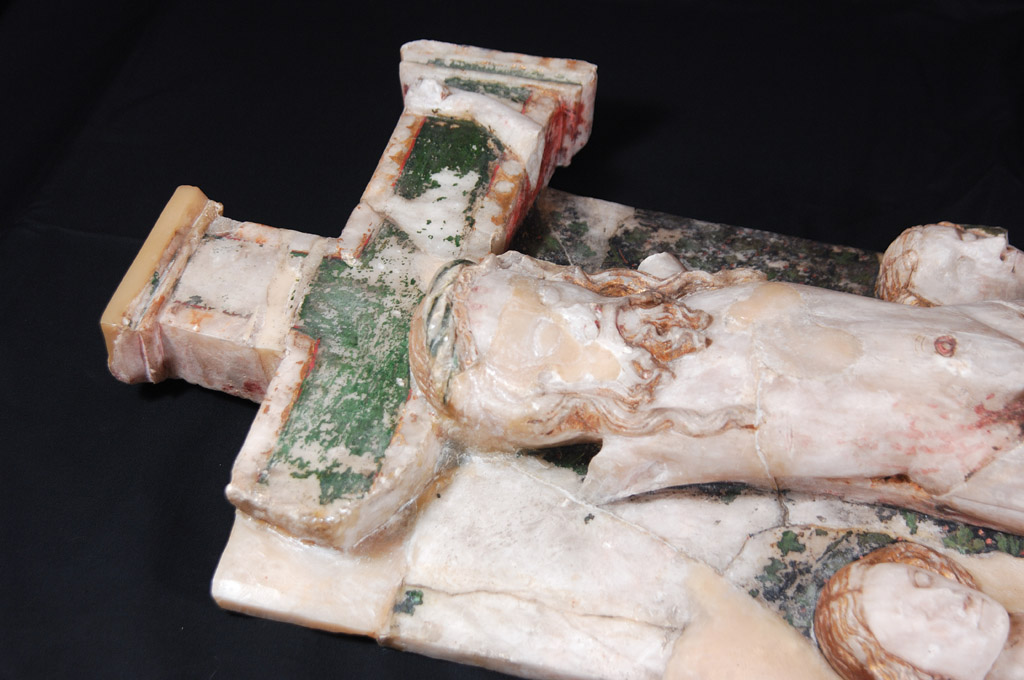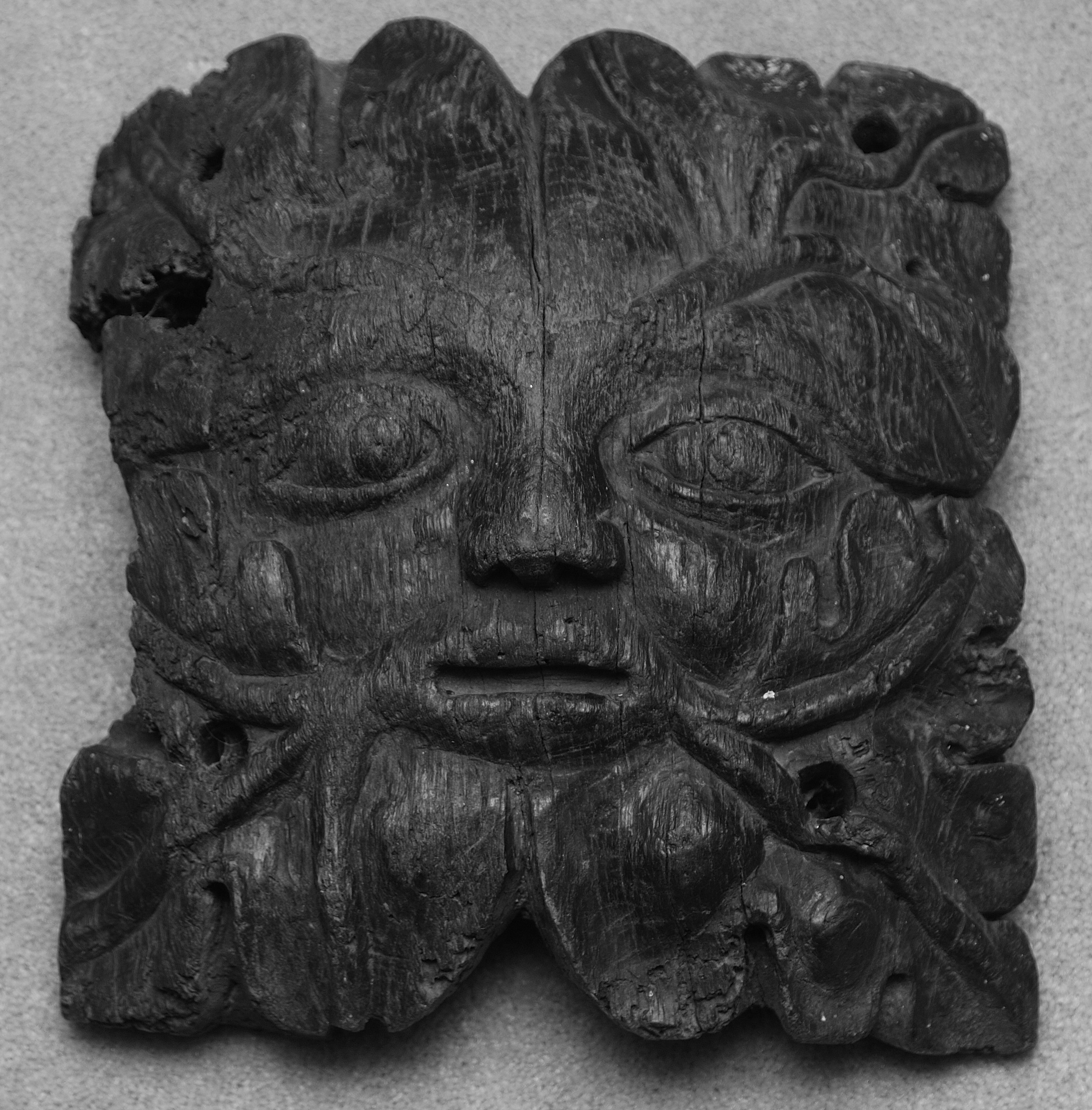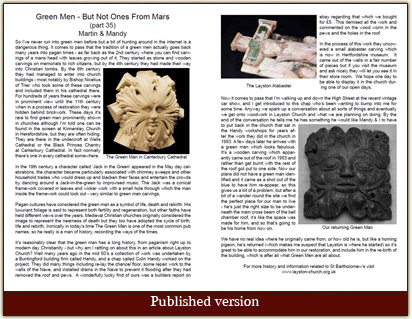Martin & Mandy
 So I've never run into green men before but a bit of hunting around in the internet is a dangerous thing. It comes to pass that the tradition of a green men actually goes back many years into pagan times - as far back as the 2nd century where you can find carvings of a mans head with leaves growing out of it. They started as stone and wooden carvings on memorials to rich citizens, but by the 4th century they had made their way into Christian tombs. By the 6th century they had managed to enter into church buildings - most notably by Bishop Nicetius of Trier who took some of these carvings and included them in his cathedral there. For hundreds of years these carvings were in prominent view until the 11th century when in a process of restoration they were hidden behind brickwork. These days it's rare to find green men prominently shown in churches although I'm told one can be found in the screen at Kinnersley Church in Herefordshire, but they are often hiding. They are there in the undercroft at Wells Cathedral or the Black Princes Chantry at Canterbury Cathedral. In fact normally there's one in every cathedral somewhere.
So I've never run into green men before but a bit of hunting around in the internet is a dangerous thing. It comes to pass that the tradition of a green men actually goes back many years into pagan times - as far back as the 2nd century where you can find carvings of a mans head with leaves growing out of it. They started as stone and wooden carvings on memorials to rich citizens, but by the 4th century they had made their way into Christian tombs. By the 6th century they had managed to enter into church buildings - most notably by Bishop Nicetius of Trier who took some of these carvings and included them in his cathedral there. For hundreds of years these carvings were in prominent view until the 11th century when in a process of restoration they were hidden behind brickwork. These days it's rare to find green men prominently shown in churches although I'm told one can be found in the screen at Kinnersley Church in Herefordshire, but they are often hiding. They are there in the undercroft at Wells Cathedral or the Black Princes Chantry at Canterbury Cathedral. In fact normally there's one in every cathedral somewhere.
In the 19th century a character called 'Jack in the Green' appeared in the May day celebrations, the character became particularly associated with chimney sweeps and other household trades who would dress up and blacken their faces and entertain the crowds by dancing around a Jack-in-the-green to improvised music. The Jack was a conical framework covered in leaves and wicker work with a small hole through which the man inside the framework could look out - very similar to green man carvings.
Pagan cultures have considered the green man as a symbol of life, death and rebirth. His luxuriant foliage is said to represent both fertility and regeneration, but other faiths have held different views over the years. Medieval Christian churches originally considered the image to represent the nearness of death but they too have adopted the cycle of birth, life and rebirth. Ironically in today's time The Green Man is one of the most common pub names, so he really is a man of history, recording the ways of the times.
 It's reasonably clear that the green man has a long history, from paganism right up to modern day Christianity - but why am I rattling on about this in an article about Layston Church? Well many years ago in the mid 50's a collection of work was undertaken by a Buntingford building firm called Handy, and a chap called Colin Handy worked on the project. They did many things including re-lay the chancel floor, some repair work to the walls of the Nave, and installed drains in the Nave to prevent it flooding after they had removed the roof and pews. A wonderfully lucky find of ours was a builders report on ebay regarding that which we bought for £5. This itemised all the work and commented on the wood worm in the pews and the holes in the roof.
It's reasonably clear that the green man has a long history, from paganism right up to modern day Christianity - but why am I rattling on about this in an article about Layston Church? Well many years ago in the mid 50's a collection of work was undertaken by a Buntingford building firm called Handy, and a chap called Colin Handy worked on the project. They did many things including re-lay the chancel floor, some repair work to the walls of the Nave, and installed drains in the Nave to prevent it flooding after they had removed the roof and pews. A wonderfully lucky find of ours was a builders report on ebay regarding that which we bought for £5. This itemised all the work and commented on the wood worm in the pews and the holes in the roof.
 In the process of this work they uncovered a small alabaster carving which is now in Hertfordshire museum. It came out of the walls in a fair number of pieces but if you visit the museum and ask nicely they will let you see it in their store room. We hope one day to be able to display it in the church during one of our open days.
In the process of this work they uncovered a small alabaster carving which is now in Hertfordshire museum. It came out of the walls in a fair number of pieces but if you visit the museum and ask nicely they will let you see it in their store room. We hope one day to be able to display it in the church during one of our open days.
 Now it comes to pass that I'm walking up and down the High Street at the recent vintage car show, and I get introduced to this chap who's been wanting to bump into me for some time. Anyway we spark up a conversation about all sorts of things and eventually we get onto woodwork in Layston Church and what we are planning on doing. By the end of the conversation he tells me he has something he would like Mandy & I to have to put back in the church that sat in the Handy workshops for years after the work they did in the church in 1953. A few days later he arrives with a green man which looks fabulous. It's a wooden carving which apparently came out of the roof in 1953 and rather than get burnt with the rest of the roof got put to one side. Now our plans did not have a green man identified and it came as a shot out of the blue to have him re-appear, so this gives us a bit of a problem, but after a bit of a wander round the site we find the perfect place for our man to live - he's just the right size to be underneath the main cross beam of the bell chamber roof, it's like the space was made for him, and so that's going to be his home from now on.
Now it comes to pass that I'm walking up and down the High Street at the recent vintage car show, and I get introduced to this chap who's been wanting to bump into me for some time. Anyway we spark up a conversation about all sorts of things and eventually we get onto woodwork in Layston Church and what we are planning on doing. By the end of the conversation he tells me he has something he would like Mandy & I to have to put back in the church that sat in the Handy workshops for years after the work they did in the church in 1953. A few days later he arrives with a green man which looks fabulous. It's a wooden carving which apparently came out of the roof in 1953 and rather than get burnt with the rest of the roof got put to one side. Now our plans did not have a green man identified and it came as a shot out of the blue to have him re-appear, so this gives us a bit of a problem, but after a bit of a wander round the site we find the perfect place for our man to live - he's just the right size to be underneath the main cross beam of the bell chamber roof, it's like the space was made for him, and so that's going to be his home from now on.
We have no real idea where he originally came from, or how old he is, but like a homing pigeon, he's returned (which makes me suspect that Layston is where he started) so it's great to be able to accommodate him in our restoration, and include him in the re-birth of the building, which is after all what Green Men are all about.
 |
|
 |

